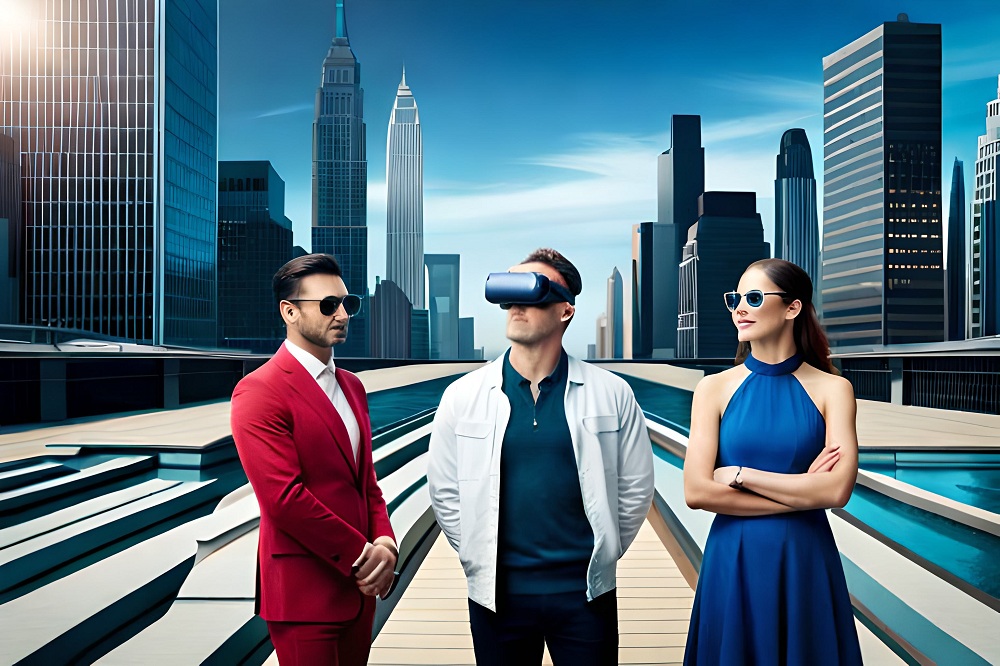Article Outline
Introduction
Understanding Augmented Reality (AR)
2.1 Definition of AR
2.2 How AR works
Applications of Augmented Reality
3.1 AR in Entertainment
3.2 AR in Education
3.3 AR in Healthcare
3.4 AR in Architecture and Design
3.5 AR in Manufacturing and Engineering
Exploring Virtual Reality (VR)
4.1 Definition of VR
4.2 How VR works
Applications of Virtual Reality
5.1 VR in Gaming
5.2 VR in Training and Simulation
5.3 VR in Therapy and Rehabilitation
5.4 VR in Travel and Tourism
Augmented Reality vs. Virtual Reality
6.1 Key differences between AR and VR
6.2 Complementary aspects of AR and VR
Future Potential and Challenges
7.1 Advancements in AR and VR technologies
7.2 Challenges and limitations
Impacts on Society and Industries
8.1 Enhancing entertainment experiences
8.2 Revolutionizing education and training
8.3 Transforming healthcare practices
8.4 Streamlining design and manufacturing processes
8.5 Shaping the future of various industries
Ethical Considerations and Privacy Concerns
9.1 Privacy implications of AR and VR
9.2 Ethical considerations in AR and VR usage
Conclusion
FAQs
11.1 How accessible are AR and VR technologies?
11.2 Can AR and VR be used together?
11.3 Are there any health risks associated with AR and VR?
11.4 Can AR and VR replace traditional education?
11.5 What industries are investing in AR and VR technologies?
Augmented Reality (AR) and Virtual Reality (VR) have rapidly emerged as transformative technologies, revolutionizing the way we perceive and interact with the world around us. In recent years, AR and VR have gained significant attention due to their remarkable potential across various domains, including entertainment, education, healthcare, and many others. This article delves into the power of AR and VR, exploring their applications, differences, future potential, impacts on society and industries, as well as ethical considerations and privacy concerns.
Introduction
In today’s digital age, technology continues to push boundaries and reshape our experiences. AR and VR are two remarkable advancements that have taken the world by storm. Augmented Reality overlays virtual elements onto the real world, enhancing our perception and providing an interactive experience. On the other hand, Virtual Reality immerses users in a computer-generated environment, transporting them to entirely new realms. Both technologies have the ability to captivate and engage users in unique ways.
Understanding Augmented Reality (AR)
2.1 Definition of AR
Augmented Reality refers to the integration of digital information or virtual objects with the user’s real-world environment. It bridges the gap between the physical and digital realms by overlaying computer-generated content onto the real world in real-time. AR enhances our perception by adding virtual elements such as images, videos, or 3D models to our immediate surroundings.
2.2 How AR works
AR operates through a combination of hardware and software components. Typically, AR systems utilize a camera to capture the real-world environment, sensors to track the user’s movements, and a display to present the augmented content. The captured real-world data is processed in real-time, allowing the AR system to accurately overlay virtual elements onto the user’s view. Advanced algorithms and computer vision techniques enable the system to understand the user’s context and seamlessly integrate the virtual content into their environment.
Applications of Augmented Reality
3.1 AR in Entertainment
AR has transformed the entertainment industry by offering unique and immersive experiences. From interactive gaming experiences to live event enhancements, AR brings fictional characters, creatures, and objects into our real-world environment. AR mobile apps like Pokémon Go have gained immense popularity, allowing users to capture virtual creatures in real locations. Additionally, AR has been used in marketing campaigns, enabling users to scan products and unlock interactive content.
3.2 AR in Education
AR has the potential to revolutionize education by making learning more engaging and interactive. It allows students to visualize complex concepts, explore virtual models, and interact with educational content in a three-dimensional space. For example, AR can bring historical events to life, allowing students to witness significant moments firsthand. It can also provide virtual lab environments for conducting experiments and simulations, enhancing practical learning experiences.
3.3 AR in Healthcare
AR is making significant strides in the healthcare industry, improving patient care and medical training. Surgeons can utilize AR to overlay patient data, such as X-ray images or vital signs, directly onto their field of view during surgeries. This technology enhances precision and reduces the risk of errors. AR is also used for training medical professionals, simulating complex procedures and providing real-time guidance.
3.4 AR in Architecture and Design
AR has transformed the field of architecture and design by allowing architects and designers to visualize and present their concepts more effectively. With AR, professionals can superimpose virtual models of buildings, interiors, and landscapes onto physical spaces, giving clients a realistic preview of the final outcome. This technology enables better collaboration, faster decision-making, and improved client satisfaction.
3.5 AR in Manufacturing and Engineering
AR is revolutionizing manufacturing and engineering processes by enhancing productivity, efficiency, and safety. In manufacturing, AR can provide real-time assembly instructions, highlighting the steps and components required for each task. This technology reduces errors and speeds up the production process. AR also enables engineers to visualize and test prototypes in a virtual environment, allowing for better design iterations and cost savings.
Exploring Virtual Reality (VR)
4.1 Definition of VR
Virtual Reality refers to the creation of a simulated environment that immerses users in a computer-generated world, isolating them from the physical surroundings. VR typically involves the use of head-mounted displays (HMDs) and motion-tracking controllers to provide a fully immersive experience. Users can explore and interact with the virtual environment as if they were physically present in it.
4.2 How VR works
VR technology works by rendering realistic and interactive virtual environments. The user wears an HMD that displays stereoscopic images or videos, providing a 360-degree field of view. The HMD is often equipped with sensors that track the user’s head movements, allowing them to look around and navigate the virtual world. Motion-tracking controllers enable users to interact with objects and manipulate the virtual environment, further enhancing the immersive experience.
Applications of Virtual Reality
5.1 VR in Gaming
Virtual Reality has made a significant impact on the gaming industry, creating immersive and realistic gaming experiences. VR gaming allows players to step into virtual worlds, interact with characters and objects, and experience gameplay in a whole new way. The technology provides a heightened sense of presence and engagement, offering gamers a more intense and immersive gaming experience.
5.2 VR in Training and Simulation
VR has become a valuable tool for training and simulation purposes in various industries. From military training to flight simulations, VR offers a safe and controlled environment for practicing complex tasks and scenarios. VR simulations can replicate real-world conditions, allowing users to gain practical experience without the associated risks and costs. Industries such as healthcare, aviation, and manufacturing use VR for training employees and improving performance.
5.3 VR in Therapy and Rehabilitation
Virtual Reality is proving to be an effective tool for therapy and rehabilitation. It has been used to treat phobias, post-traumatic stress disorder (PTSD), and anxiety disorders. VR environments can create controlled situations that help patients confront their fears and anxieties in a safe and supportive setting. In rehabilitation, VR is used to facilitate motor skills training and cognitive therapy, providing interactive and motivating exercises for patients.
5.4 VR in Travel and Tourism
VR has the potential to transform the travel and tourism industry by offering virtual travel experiences. Through VR, users can explore famous landmarks, visit exotic destinations, and experience different cultures, all from the comfort of their homes. VR travel experiences provide a glimpse into destinations, helping travelers make informed decisions and inspiring them to plan their future trips.
Augmented Reality vs. Virtual Reality
6.1 Key differences between AR and VR
While both AR and VR technologies provide immersive experiences, there are fundamental differences between the two:
- Augmented Reality overlays virtual content onto the real world, enhancing our perception of the environment. Virtual Reality, on the other hand, creates a fully simulated digital environment that isolates users from the physical world.
- AR enhances the existing reality by adding virtual elements, while VR replaces the real world with a virtual one.
- AR allows users to interact with the real world and virtual objects simultaneously, whereas VR focuses on creating an immersive experience without real-world interaction.
6.2 Complementary aspects of AR and VR
Although AR and VR are distinct technologies, they can also complement each other in certain applications. Mixed Reality (MR) combines elements of both AR and VR, allowing users to interact with virtual content while maintaining awareness of the real world. MR enables users to manipulate and interact with virtual objects in their physical environment, creating a seamless integration of digital and real-world elements.
Future Potential and Challenges
7.1 Advancements in AR and VR technologies
AR and VR technologies are rapidly advancing, unlocking new possibilities and pushing the boundaries of what is achievable. As hardware becomes more compact and affordable, AR and VR experiences are becoming more accessible to a wider audience. Advancements in graphics processing, display technology, and tracking systems are enhancing the realism and immersion of these experiences. Additionally, the integration of AI and machine learning algorithms is enabling more intelligent and interactive virtual content.
7.2 Challenges and limitations
While AR and VR hold immense potential, there are several challenges and limitations that need to be addressed. One major challenge is the development of high-quality and realistic content. Creating detailed and interactive virtual environments requires significant resources and expertise. Additionally, issues such as motion sickness, eye strain, and discomfort during prolonged VR usage need to be addressed for wider adoption. Privacy concerns and ethical considerations surrounding data collection and user consent also need careful attention.
Impacts on Society and Industries
8.1 Enhancing entertainment experiences
AR and VR have revolutionized the entertainment industry, offering immersive and interactive experiences. From gaming to live events and theme parks, these technologies provide new ways to engage and entertain audiences. AR and VR enable users to become active participants in their entertainment, blurring the line between the real and virtual worlds.
8.2 Revolutionizing education and training
AR and VR have the potential to transform education and training methodologies. By providing immersive and interactive learning experiences, these technologies can enhance knowledge retention and engagement. Students can explore historical events, visit distant locations, and engage in realistic simulations that facilitate deeper understanding and practical skill development.
8.3 Transforming healthcare practices
AR and VR have significant applications in healthcare, improving patient care, diagnostics, and training. Surgeons can use AR to overlay vital patient information during surgeries, increasing precision and reducing risks. VR simulations allow medical professionals to practice complex procedures in a safe environment. VR therapy is being used to treat mental health conditions, offering new avenues for intervention and rehabilitation.
8.4 Streamlining design and manufacturing processes
AR and VR technologies are transforming design and manufacturing industries. Architects and designers can use AR to visualize and present concepts, streamlining the design process and improving client communication. VR allows engineers to test and optimize prototypes virtually, reducing costs and time. These technologies enhance collaboration and efficiency in various industries, resulting in better products and experiences.
8.5 Shaping the future of various industries
AR and VR have the potential to reshape multiple industries, including retail, tourism, real estate, and automotive. In retail, AR can enhance the shopping experience by allowing customers to try on virtual clothing or visualize furniture in their homes. VR can provide virtual property tours, enabling buyers to explore properties remotely. Automotive companies can use AR to provide real-time information on vehicle performance and navigation. These technologies offer innovative solutions and redefine the way industries engage with customers.
Ethical Considerations and Privacy Concerns
9.1 Privacy Implications of AR and VR
The rise of AR and VR technologies has raised concerns regarding user privacy. As these technologies collect and process user data to provide personalized experiences, it is crucial to ensure transparency and obtain user consent for data collection and usage. Safeguarding sensitive information and protecting user privacy should be a top priority. Establishing regulations and guidelines is necessary to address these privacy implications.
9.2 Ethical Considerations in AR and VR Usage
The increased prevalence of AR and VR technologies also calls for ethical considerations in their usage. Designers and developers must be mindful of the potential impact their creations may have on users’ mental and emotional well-being. It is important to avoid content that may induce fear, anxiety, or harm. Additionally, responsible design practices should be employed to address ethical dilemmas that may arise, such as the simulation of sensitive or traumatic events. Responsible usage and content moderation are essential in creating a safe and respectful virtual environment.
Conclusion
In conclusion, AR and VR technologies have emerged as powerful tools with the potential to reshape various aspects of our lives. From enhancing entertainment experiences to revolutionizing education, healthcare, and industries, the applications of AR and VR are vast. However, it is crucial to address the ethical considerations and privacy concerns associated with these technologies. By ensuring responsible design practices, transparency in data usage, and content moderation, we can harness the full potential of AR and VR while prioritizing user well-being and privacy.
FAQs (Frequently Asked Questions)
11.1 How Accessible Are AR and VR Technologies?
AR and VR technologies are becoming more accessible with advancements in hardware and software. However, there are still accessibility challenges that need to be addressed. Designing intuitive interfaces, incorporating assistive technologies, and considering the needs of individuals with disabilities are important steps in making AR and VR experiences more inclusive and accessible.
11.2 Can AR and VR Be Used Together?
Yes, AR and VR can be used together in certain applications. Mixed Reality (MR) combines elements of both technologies, allowing users to interact with virtual content while maintaining awareness of the real world. This integration creates a seamless and immersive experience that blends virtual and physical elements.
11.3 Are There Any Health Risks Associated with AR and VR?
Extended usage of AR and VR technologies can potentially cause health issues such as eye strain, motion sickness, and discomfort. It is important for users to take regular breaks, adjust settings for comfort, and use devices that meet safety standards. Manufacturers and developers are actively working to minimize these risks through improved hardware and software design.
11.4 Can AR and VR Replace Traditional Education?
AR and VR technologies have the potential to enhance traditional education by providing immersive and interactive learning experiences. However, they are not intended to replace traditional education entirely. Instead, they can be powerful tools to supplement and enrich learning environments, offering new avenues for exploration, engagement, and practical skill development.
11.5 What Industries Are Investing in AR and VR Technologies?
Numerous industries are investing in AR and VR technologies. Some prominent examples include gaming and entertainment, education and training, healthcare, architecture and design, tourism and hospitality, automotive, and retail. These industries recognize the transformative potential of AR and VR in enhancing experiences, improving efficiency, and creating innovative solutions.



